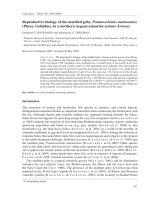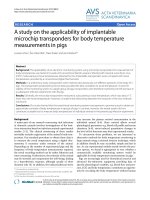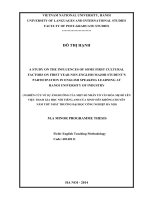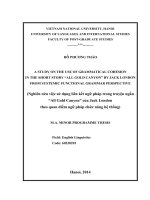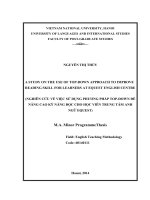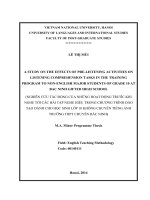study on reproductive biology of vermiculated sailfin catfish (pterygoplichthus disjunctivus weber, 1991) in can tho and đong thap provinces
Bạn đang xem bản rút gọn của tài liệu. Xem và tải ngay bản đầy đủ của tài liệu tại đây (1.59 MB, 67 trang )
CAN THO UNIVERSITY
COLLEGE OF AQUACULTURE AND FISHERIES
STUDY ON REPRODUCTIVE BIOLOGY OF VERMICULATED
SAILFIN CATFISH (Pterygoplichthus disjunctivus Weber, 1991) IN
CAN THO AND ĐONG THAP PROVINCES
By
NGUYEN KIM CUONG
A thesis submitted in partial fulfillment of the requirements for
the degree of Bachelor of Aquaculture Science
Can Tho, December 2013
CAN THO UNIVERSITY
COLLEGE OF AQUACULTURE AND FISHERIES
STUDY ON REPRODUCTIVE BIOLOGY OF VERMICULATED
SAILFIN CATFISH (Pterygoplichthys disjunctivus Weber, 1991) IN
CAN THO AND ĐONG THAP PROVINCES
By
NGUYEN KIM CUONG
A thesis submitted in partial fulfillment of the requirements for
the degree of Bachelor of Aquaculture Science
Supervisor
Assoc. Prof. Dr. TRAN DAC DINH
Can Tho, December 2013
i
APPROVEMENT
The thesis “Study on reproductive biology of vermiculated sailfin catfish
(Pterygoplichthys disjunctivus Weber, 1991) in Can Tho and Dong Thap
provinces” defended by Nguyen Kim Cuong, which was edited and passed by
committee on 12-27-2013
Sign of Supervisor Sign of Student
Assoc. Prof. Dr Tran Dac Dinh Nguyen Kim Cuong
ii
ACKNOWLEDGEMENT
My special thanks are given to Assoc. Prof. Dr. Tran Dac Dinh for his
constant guidance and useful advices that helped me to conduct and complete this
thesis.
Thanks to the teaching staffs in department of fisheries management and
economics, College of Aquaculture and Fisheries – Can Tho University and
students of Advanced Aquaculture Program Class Course 2
nd
for enthusiasm help
during the period of sampling and data analysis.
Thanks to Miss. Ho Thi Thuy Huong and Nguyen Thi Vang help me during
the period of experimentation and data analysis.
Finally, I would like to thank to my family and friends helped and made the
best conditions for me during my study of bachelor program in aquaculture.
Nguyen Kim Cuong
iii
ABTRACT
This thesis studied on reproductive biology of vermiculated sailfin catfish
(Pterygoplichthys disjunctivus,Weber 1991) in Can Tho and Dong Thap provinces
from July to October in 2013. The results indicated that length-weight relationships
were very close with high R
2
, including total length-weight relationship equation
W=0.0115L
2.8967
with R
2
= 0.9759 (n=216) and standard length-weight relationship
equation W=0.0759L
2.5647
with R
2
= 0.9485 (n=216). Besides, condition factor (CF)
of males was the highest in September (0.0119) and the lowest was in October
(0.0111), CF of females was the highest in October (0.0119) and the lowest CF was
in August (0.0112). Next, maturity proportion was the highest in July (90%) and the
lowest was in September (69.61%),most of males were mature in July and August
(more than 70% ) and the females were mature in 4 months from July to October
(more than 90%), sex proportion were 93 females (43.06% ), 123 males (56.94% )
and sex ratio ( female: male) was 1 : 1.32. In addition, Gonadosomatic index (GSI)
of males was the highest in August (0.6175%) and the lowest was in October
(0.0659%), GSI of females were very high (5.5246% -8.3018%), the highest was in
October (8.3018%) and the lowest was in August (5.5246%). Hepatosomatic index
(HSI) of males was the highest in August (1.1195%) and the lowest was in October
(0.8378%), HSI of females also was the highest in August (1.2109%) and the lowest
was in October (0.8388%). Average of fecundity of Pterygoplichthyus
disjuntivuswas 2002 eggs/female (324 – 6621 eggs/female), average of relative
fecundity was 13 eggs/gram of female (4 – 23 eggs/gram of female). The fecundity
of fish was not stable because Pterygoplichthyus disjunctivus reproduced many time
per year. Fecundity – weight relationship of Pterygoplichthyus disjuntivuswas
indicated by equation F = 16.203W
0.9456
with R
2
= 0.836.Finally, total length at first
maturity was indicated by equation y = -0.639x + 9.926 with R
2
= 0.842, the result
of total length at first maturity was 15.53 cm.
iv
TABLE OF CONTENT
Acknowledgements i
Abstract iii
TABLE OF CONTENT iv
LIST OF TABLES vi
List of figures vii
LIST OF ABBREVIATIONS viii
CHAPTER I 1
INTRODUCTION 1
1. Background of the research 1
2. Research objective 2
3. Research contents 3
CHAPTER II 4
LITERATURE 4
1. Overview of natural condition, aquaculture and fisheries in Can Tho 4
2.Overview of natural condition, aquaculture and fisheries in Dong Thap 5
3. Classification, morphological characteristics and distribution of
Pterygoplichthyus disjunctivus (Weber, 1991) 7
4. Nutritional characteristics 8
5. Growth characteristics 8
6.Reproduction characteristics 9
7. Environmental impacts 10
CHAPTER III 12
MATERIALS AND METHODOLOGY 12
1. Materials 13
2. Methodology 13
2.1 Sampling and fixing samples 13
2.2 Criteria for sample analysis 13
2.3 Length-weight relationship and condition factor (CF) 13
2.4 Maturity stages, maturity proportion and sex ratio 14
2.5 Gonadosomatic Index (GSI) 15
2.6 Hepatosomatic Index (HSI) 16
2.7 Fecundity 16
v
2.8 Total length at first maturity (Lm) 17
2.9 Data analysis method 17
CHAPTER IV 18
RESULTS AND DISCUSSIONS 18
1. Morphological criteria and characteristics 18
2. Length – weight relationship and condition factor (CF) 20
2.1 Total length – weight relationship 20
2.2 Standard length – weight relationship 20
2.3 Condition factor (CF) 22
3. Maturity stages, maturity proportion and sex ratio 23
3.1 Maturity proportion and maturity stages 23
3.2 Sex ratio 25
4. Gonadosomatic index (GSI) 26
6. Fecundity 29
7. Total length at first maturity 31
CHAPTER V 32
CONCLUSIONS AND RECOMMENDATIONS 32
1.Conclusions 32
1.1 Length-weight relationship and condition factor 32
1.2 Gonadosomatic index (GSI) 32
1.3 Hepatosomatic index (HSI) 33
1.4 Fecundity 33
1.5 Total Length at first maturity 33
2 Recommendations 33
REFERENCE 34
APPENDIX 36
vi
LIST OF TABLES
Table 1: Description of Maturity stages (Nikolsky 1963) 15
Table 2: Comparison of morphological criteria between Pterygoplichthyus
disjunctivus (Weber, 1991) with other researchs 18
Table 3:Propotion of morphological criteria of Pterygoplichthyus disjunctivus 18
Table 4: Condition factor (CF) of Pterygoplichthyus disjunctivus (males) 22
Table 5: Condition factor (CF) of Pterygoplichthyus disjunctivus (females) 22
Table 6: Maturity proportion (%) of Pterygoplichthyus disjunctivus 23
Table 7: Sex proportion (%) and sex ratio of Pterygoplichthyus disjunctivus in every
month 26
Table 8: Gonadosomatic index of Pterygoplichthyus disjunctivus (males) 26
Table 9: Gonadosomatic index of Pterygoplichthyus disjunctivus (females) 27
Table 10: Hepatosomatic index of Pterygoplichthyus disjunctivus (males) 28
Table 11: Hepatosomatic index of Pterygoplichthyus disjunctivus (females) 29
Table 12: Determination of total length at first maturity of Pterygoplichthyus
disjunctivus 31
vii
LIST OF FIGURES
Figure 1: Vermiculated sailfin catfish (Pterygoplichthys disjunctivus Weber,1991) 1
Figure 2: Sampling area in Can Tho 12
Figure 3: Sampling area in Dong Thap 12
Figure 4: Vermiculated sailfin catfish (Pterygoplichthyus disjunctivus Weber, 1991)
19
Figure 5: Sucker mouth of Vermiculated sailfin catfish (Pterygoplichthyus
disjunctivus Weber, 1991) 19
Figure 6: Total length – weight relationship of Pterygoplichthyus disjunctivus 20
Figure 7: Standard length–weight relationship of Pterygoplichthyus disjunctivus 21
Figure 8: Condition factor (CF) of Pterygoplichthyus disjunctivus (males) 22
Figure 9: Condition factor (CF) of Pterygoplichthyus disjunctivus (females) 23
Figure 10: Maturity stages proportion (%) of males 24
Figure 11: Maturity stages Proportion (%) of females 25
Figure 12: Sex proportion of Pterygoplichthyus disjunctivus in 4 months 25
Figure 13: Gonadosomatic index of pterygoplichthyus disjunctivus (males) 26
Figure 14: Gonadosomatic index of Pterygoplichthyus disjunctivus (females) 27
Figure 15: Hepatosomatic index of Pterygoplichthyus disjunctivus (males) 28
Figure 16: Hepatosomatic index of Pterygoplichthyus disjunctivus (females) 29
Figure 17: Fecundity – weight relationship of Pterygoplichthyus disjunctivus 30
Figure 18: Total lenght at first maturity of Pterygoplichthyus disjunctivus 31
viii
LIST OF ABBREVIATIONS
P
Pectoral fin
V
Ventral fin
A
Anal fin
D
Dorsal fin
W
Weight of fish
L
Length of fish
TL
Total length
FL
Fork length
SL
Standard length
CF
Condition factor
GSI
Gonadosomatic index
HIS
Hepatosomatic index
F
Fecundity
L
m
Total length at first maturity
n
Amount of samples
G
Weight of the ovaries
g
Weight of the sub-sample
P
Maturity proportion
W
L
Weight of liver
GW
Gonad weight
BW
Body weight
1
CHAPTER I
INTRODUCTION
1. Background of the research
Vermiculated sailfin catfish (Pterygoplichthys disjunctivus Weber,
1991) distributed in the North and Central America, Asia, Caribbean area and
Hawaii. It invaded many states, including Florida, Texas, and especially
Hawaii, it was nonnative and harmful specie. It can live in relatively cool, fast-
flowing and oxygen-rich highland streams to slow-flowing, warm lowland
rivers and oxygen- poorstagnant pools. Besides, it also has wide amplitude of
temperature, although be a tropical specie but it can service in cold areas in the
Winter. It is also highly tolerant to poor water quality and is commonly found
in polluted waters. Specially, Vermiculated sailfin catfish can move on land at
a certain distance. It is omnivore but main foods are algae and seaweed on the
bottom or surface of aquatic plants. Abundance of Vermiculated sailfin catfish
is the cause of declining some native aquatic species because it not only vies
food but also eats eggs of other species, controlling is very difficult if it
invades with high density.
Figure 1: Vermiculated sailfin catfish (Pterygoplichthys
disjunctivusWeber,1991)
2
In Viet Nam, special concern is development of vermiculated sailfin
catfish with high density in wetlands natural conserves such as Tram Chim, U
Minh Thuong, Lang Sen, Tan Hung, Lung Ngoc Hoang and rivers, channels,
canals, lakes,… in Mekong Delta leads to disturbance ecosystems and
biological imbalance.
In Me Kong Delta, the people worry so much about vermiculated
sailfin catfish, it not only lives in rivers, ponds, lakes, channels…but also lives
in ponds for aquaculture, potential effects of them include alteration of bank
structure and erosion, disruption of aquatic food chains, competition with
native species, mortality of endangered shore birds, changes in aquatic plant
communities and damage to fishing gear and industry.
Some provinces have high density of vermiculated sailfin catfish are
Can Tho, An Giang, Dong Thap, Soc Trang, Vinh Long, Tra Vinh, specially is
in Can Tho and Dong Thap. Controlling can be done easily in ponds for
aquaculture by draining and cleaning ponds but it is very difficult to do in
natural conserves.
Researches about species composition, biological characteristics,
growth characteristics, its impacts on the ecosystem, competition with other
species, its regions of residence, fertility, measures to control…of
vermiculated sailfin catfish need to be done to have accurate appraisal and
effective methods for management, protection and development aquatic
resources. So topic “study on reproductive biology of the vermiculated sailfin
catfish in Can Tho and Dong Thap provinces ” is very necessary.
2. Research objective
To find out some reproductive biological characteristics of
vermiculated sailfin catfish (Pterygoplichthys disjunctives Weber 1991)
distributed in Can Tho and Dong Thap provinces to provide data for
management reproduction of vermiculated sailfin catfish and protection,
development of native aquatic species.
3
3. Research contents
To study some reproductive biological characteristics such as: length-
weight relationship, condition factor (CF), sex ratio, stages of maturity,
maturity proportion, gonadosomatic index (GSI), hepatosomatic index (HSI),
total length at first maturity and fecundity.
4
CHAPTER II
LITERATURE
1. Overview of natural condition in Can Tho
Can Tho is directly under the Central authorities, lies in the heart of the
Mekong River Delta, bordered by An Giang and Dong Thap in the north, Vinh
Long in the East , Hau Giang in the South and Kien Giang in the West. Being
dubbed as “the capital city of the Southwestern Vietnam” more than one
hundred years ago, Can Tho became the level 1 city and one of the four
provinces and cities of the Mekong River Delta Key Economic Zone–the
fourth key economic zone of Vietnam. Can Tho not only has favorable natural
conditions and geographical position to develop agriculture, fishery but also
develop others such as urban infrastructure, traffic infrastructure, hi-tech
agriculture, agricultural aquatic products and seafood processing industry,
tourism and supportive industries.
Area: 1,389.60 km
2
Population: 1.2 million people (2012)
Population density: 856 people/ km
2
(2012)
Climate: Can Tho belongs to the tropics with two distinct seasons: the
rainy season is from May to November, and the dry season is from December
to April. The annual average temperature was 27
0
C; the annual average
rainfall was 1,635 mm; the annual average humidity was 83%. There are two
main wind direction, northeast wind (dry season) and southwest wind ( rain
season), average wind speed was 1.8 m/s, few storms but it will be in rain
season.
Topography: Can Tho has relatively flat terrain, average height is
about 1 – 2 m, It is convenient for agriculture and fishery production. Can Tho
lies in the half-flooded plains that were gradually sloping from northeast to
southwest, including three kinds of terrain: natural dikes alongside Hau River
(forming the strip of high land and islands along Hau River); half-flooded
5
plains (belonging to the Long Xuyen Tetragon that is directly influenced by
the flood every year); delta plains (mainly influenced by the tide and some
interactive influences from the crop-end floods).
Hydrology: Can Tho had dense river, channel, canal system and many
islets on Hau river. Hau river is the biggest river with total length run through
Can Tho is about 65km and the width is about 1.6 km, total water quantity
flow to the sea was about 200 billions m
3
/year (make up about 41% of total
water volume of Me Kong river), total alluvium was about 35 millions m
3
/year
(near ½ total alluvium of Me Kong river). Can Tho river is from the West of
Hau river with 16 km in length and 280-350 m, flow through O Mon, Phong
Dien, Cai Rang, Ninh Kieu provinces, it has freshwater year round which help
for irrigation in dry season, drainage in rain season and transportation.
Besides, there are many other rivers and channel such as Thot Not, Vinh
Thanh, Co Do, Phong Dien that help for soil improvement, irrigation,
breeding, cultivation…
Administrative organization: Can Tho City has 9 administrative units
including 5 urban districts of Ninh Kieu, Binh Thuy, Cai Rang, O Mon, Thot
Not and four suburban districts of Phong Dien, Co Do, Thoi Lai, Vinh Thanh
with 5 towns, 44 wards and 36 communes (statistical data from the time of
issuing the Decree 12/ND-CP).
2.Overview of natural condition in Dong Thap
Dong Thap is a province in the Mekong Delta region of southern
Vietnam, bordered by Pray Veng province (Cambodia) in the North with a
length of more than 48km, Vinh Long and Can Tho in the South, An Giang in
the West and Long An and Tien Giang in the East. Dong Thap has many
advantages to develop agriculture, aquaculture, agricultural aquatic products
and seafood processing industry, tourism and supportive industries.
Area: 3,376.4km
2
(2011)
Population: 1.673.200 (2011)
6
Topography: quite flat with a sloping tendency from North to South
and West to East; separating into two large regions: one is in the North of Tien
River (having an area of 250,731ha, in Dong Thap Muoi area) and one is in
the South of Tien River (having an area of 73,074 ha, lying between Tien
River and Hau River). Dong Thap has benefits from a large river, channel and
spring system, frequently silt-aggraded soil, permanently fresh and non-saline
water source.
Climate: Dong Thap is in the tropical climate zone, consistently in the
whole province. There are two evident seasons; rainy season from May to
November, and dried season from December to April of the following year.
Average rainfall ranged from 1,682-2,005mm, mostly in rainy season, which
accounted for 90-95% of annual rainfall. Such climate was advantageous for
agricultural development. The average temperature was 27
0
C, of which the
highest was 34.3
0
C, and the lowest was 21.8
0
C.
Hydrology: under the influence of three factors: floodwater from upper
Mekong River, in-field rain and tides of the South East Asia Sea. The
hydrologic regime is divided into 2 seasons: exhausted season from December
to June of the following year and flood season from July to November. Dong
Thap has abundant surface water, fresh water year round, two rivers branch
are So Ha river and So Thuong river from Cambodia flew to Tien river in
Hong Ngu, there are also many rivers in the South such as Cai Tau Ha, Cai
Tau Thuong, Sa Dec….Specially, Dong Thap also has underground water
reservoir with different depth.
Administrative organization: With an area of 3,374km2, Dong Thap is
divided into twelve administrative regions: one provincial city (Cao Lanh),
two towns (Sa Dec and Hong Ngu) and nine districts (Cao Lanh, ThapMuoi,
Thanh Binh, Tam Nong, Tan Hong, Hong Ngu, Chau Thanh, Lai Vung and
Lap Vo).
7
3. Classification, morphological characteristics and distribution
ofPterygoplichthyus disjunctivus (Weber, 1991)
Kingdom : Animalia
Phylum: Chordata
Subphylum: Vertebrata
Class: Actinopterygii
Order: siluriformes
Family: Loricariiadae
Genus: Pterygoplichthyus
Scientific name: Pterygoplichthyus disjunctivus (Weber, 1991)
English name: Vermiculated sailfin catfish
Vietnamese name: cálaukiếng
Loricariiadae family has about 80 genera and over 700 species,
Loricariidae isthe largest family of catfishes (Siluriformes) (Armbruster and
Page, 2006). Loricariids areendemic to South America (absent in Chile),
Panama, and CostaRica, they are characterized by having large bony plates
and a ventral sucker mouth with or without noticeable barbells, we can find
them from lowland to upland depend on characteristics of every specie, their
body size can be from some centimeter up to 1 meter (Fuller, 1999).
Most of Pterygoplichthys disjunctivus distribute in the North and
Central America, Asia, Caribbean area and Hawaii. Especially in the South of
US such as Florida, Texas and Mexico (Wakida-Kusunokiet al, 2007).
Besides, they also distribute in Oahu island (Hawaii)(Yamamoto and Tagawa,
2000), Puerto Rico (Bunkley-Williams et al, 1994) and Jamica. In Asia, they
distribute in many countries such as Singapore, Indonesia, Japan, Taiwan
(Liang et al, 2005), Thailand, Philipine, Malaysia (Page and Robins, 2006) and
Viet Nam (Levin et al, 2008).
8
Vermiculated sailfin catfish Pterygoplichthys disjunctivusis a kind of
ornamental fish imported to Viet Nam from Hong kong and Singapore. Today,
they appear with high density in natural reserves such as Tram Chim, U Minh
Thuong, Lang Sen, Lung Ngoc Hoang and rivers, channels, canals, lakes,… in
Mekong Delta.
Pterygoplichthys disjunctivuscan be different others of Loricariids due
to their large dorsal fins with nine or more (usually 10) dorsal fin rays, which
gives them their common name "sailfin catfish”. Their dorsal and lateral
surfaces covered with rough, bony plates forming flexible armor; the abdomen
is almost completely covered in small plates, the head is terete and naked.
Other characteristics of members of this genus include an inferior sucker
mouth with thick, fleshy lips form a sucking disc for attaching to rocks and
grazing on algae, they have adipose fin present, and an enlarged stomach
connected to the dorsal abdominal wall by a connective tissue sheet. The color
is generally dark brown or black.
4. Nutritional characteristics
The stomach of Pterygoplichthys disjunctivus is greatly expanded with
the posterior portion forming a long, thin sac that is highly vascularized. Their
mouth can cling to substrate even fast current of water, Pterygoplichthys
disjunctivus feed primarily on benthic algae and detritus. They may also eat
worms, insect larvae, fish eggs and other bottom-dwellers but the vast
majority of its diet consists of detritus, algae, and various plant mater.
5. Growth characteristics
The adult size of a member of Pterygoplichthys disjunctivus can range
from about 50–70 cm. the female can spawn year round, survival rate of larvae
is 70%, they can live without food up to 1 month. Their life is about 15 years
(some situation is 30 years) .
Pterygoplichthys disjunctivus can be found in a wide variety of habitats,
ranging from relatively cool, fast-flowing and oxygen-rich highland streams to
slow-flowing, warm lowland rivers and stagnant pools poor in oxygen. They
9
are tropical fish and populations are typically limited only by their lower lethal
temperature which has been found to be about 8.8-11
o
C in some species. They
can thrive in a range of acidic to alkaline waters in a range of about (pH 5.5 to
8.0). They are often found in soft waters, but can adapt very quickly to hard
waters. Pterygoplichthys disjunctivus is also highly tolerant to poor water
quality and is commonly found in polluted waters .They are known to use
outflow from sewage treatment plants as thermal refugia and can readily adapt
to changing water quality (Nico& Martin, 2001).Pterygoplichthys disjunctivus
may be found in from lowlands to elevations of up to 3,000m (Wakida-
Kusunki, 2007). Some species are salt tolerant.
6.Reproduction characteristics
Pterygoplichthys disjunctivus reproduces sexually and has high
fecundity. The males construct burrows in the banks of the rivers and lakes in
which they live. Burrow width approximates that of the occupant fish (i.e.,
width between extended pectoral fins), burrow length is typically 0.5 to 1.0 m,
and shape is variable although the tunnel usually extends downward into the
bank. These burrows are used for reproduction but also allow survival during
drought. Eggs are laid in the burrow and are guarded by males; fish can
survive in the moist microhabitat even when water levels fall far below the
opening to the chambers (Burgess 1989). Burrows may also be used as refugia
during cold weather (Nico and Martin 2001). These traits enable sailfin catfish
to thrive in their natural and in unnatural habitats. Dense populations of sailfin
catfishes (hundreds to thousands per water body) have been observed in
natural parts of their range (Burgess 1989) and in Hawaii, Puerto Rico, and
Florida (Nico 1999; Bunkley-Williams et al. 1994). Growth is rapid during the
first two years of life (more than 35 cm) and fecundity is high (472-1283
mature eggs/ female) especially in larger individuals. Consequently,
introduced populations can become abundant in a very short period of time.
Growth of Pterygoplichthys disjunctivus is rapid during the first two
years of life, with total lengths of many sailfin catfish exceeding 300 mm by
10
age 2. Specimens in aquaria may live more than 10 years. The size range for
most of the adult species in the Loricariid family is 30-50 cm, but individuals
have been observed to reach 70 cm. they start reproducing at approximately 25
cm .
7. Environmental impacts
Potential effects of vermiculated sailfin catfish include
Impacts to native species: they are at a competitive disadvantage when
confronted by larger (greater than 15 cm), longer-lived, highly productive,
environ mentally tolerant species that feed on the same foods that they do.
Because they are bottom feeders, may vermiculated sailfin catfish incidentally
ingest eggs of native fishes. Because they are benthic and large, they may
displace smaller or less aggressive benthic fishes
Alteration of bank structure and erosion: The nesting burrows of
vermiculated sailfin catfish sometimes form a large group or “spawning
colony” in which several dozen occur in very close proximity to each other
(Nikolsky 1963). These colonies can compromise shoreline stability,
increasing erosion and suspended sediment loads (Nico 2000a). Siltation, bank
failure, head cutting, and elevated turbidity are likely impacts.
Disruption of aquatic food chains: grazing on benthic algae and detritus
by vermiculated sailfin catfish alters and reduces food and physical cover.
Feeding on mud and silt could result in resuspension of sediments and/or
changes in substrate size. In addition, nutrients are prematurely diverted from
the “consumer” components of food webs and transformed into feces available
only to scatophagy and decomposers ( bacteria, fungi).
Mortality of endangered shore birds: because they are large, sedentary,
and palatable, is attractive prey to fish-eating birds. Their defensive erection of
dorsal and pectoral spines endanger to the birds attempting to swallow whole
fish.
11
Changes in aquatic plant communities: they plough the bottoms of
streams, occasionally burying their heads in the substrate and lashing their
tails .These behaviors can uproot or shear aquatic plants. This would affect
native plant species by reducing their abundance in beds of submersed aquatic
vegetation and creating mats that could shade them from sunlight.
12
CHAPTER III
MATERIALS AND METHODOLOGY
Duration: from July to October 2013
Location:
- Can Tho river, Ninh Kieu dictrict, Can Tho
- Truong Xuan commune, Thap Muoi dictrict, Dong Thap province
Figure 2: Sampling area in Can Tho
Figure 3: Sampling area in Dong Thap
Sampling
area
Sampling
area
13
1. Materials
Equipment: Bistoury, electronic scales, ruler, petri dishes, magnifying glass,
other instruments.
Chemical: Formalin, ethanol, HgCl
2
, nitric acid, pure water, glacial acetic
acid, Gilson ‘s fluid (separate eggs). Ingredients of Gilson ‘s fluid included
100ml ethanol 60
o
, 15 ml nitric acid 80%, 18 ml glacial acetic acid, 20g
mercuric chloride, 880 ml pure water.
2. Methodology
2.1 Sampling and fixing samples
- The samples were collected from 30 to 40 individuals per month with
10-45 cm in length
- The fish were sampled by fishing equipments (trawl, seine, drift net) in
rivers, canals, lakes or local market in Dong Thap and Can Tho provinces.
- Samples were washed with freshwater and recorded time and places of
sampling.
- The samples were kept fresh for morphological and biological
reproductive characteristics analysis in College of Aquaculture and Fisheries –
Can Tho University.
2.2 Criteria for sample analysis
− Weight of fish
− Total length
− Standard length
− Height of body
− Length of head
− Length of mouth
− Diameter of eyes
− Distance of eyes
− Amount of dorsal fin, pectoral fin, ventral fin and anal fin
− Gonad weight
− weight of liver
− Number of ripe eggs in sub-sample
− Weight of the ovaries
14
2.3 Length-weight relationship and condition factor (CF)
Length - weight relationship: The growth of fish could effect to its
length. The cubic equation W = a.L
b
was used for expressing the length –
weight relationship. In this equation, L and W were length and weight of fish,
respectively, b was close to 3 in isometric growth and a is constant (King,
1995)
The individual variations from general length – weight relationship had
been studied under the general name “condition.” The conditions of fish were
influenced by the seasonal changes of gonads and by the feeding intensity.
King (1995) suggested the equation for calculate condition factor (CF) as
follow:
Where:
CF: condition factor
W: weight of fish (g)
L: length of fish (cm)
b: the exponent of length – weight relationship equation in cubic form.
2.4 Maturity stages, maturity proportion and sex ratio
In this research, it was required to examine the sex of a large number of
samples. According to information in table 3Maturity stages (Nikolsky 1963)
,sexual characteristics, maturity stages, reproductive ability of fishwere
identified macroscopically by observating their gonads and using a
magnifying glass. Sex ratio depended on characteristics of species,
reproduction, habitat,…
15
Table 1: Description of Maturity stages (Nikolsky 1963)
Stage
Description
I
Young individual is not sexually mature
II
Gonads are small, eggs are invisible to naked eye
III
Mature stage, eggs are visible to naked eye, testis is from pure white
to light pink, the weight of gonad increase quickly
IV
Ripe stage, the gonad has biggest size, no fluid from gonad when
pressing
V
Spawning eggs stage, having fluid from gonad when pressing, the
weight of gonad decrease quickly
VI
After spawning stage, fluid from gonad is released completely, gonad
hole is swollen, and the gonad is very soft. The female has a few eggs
are remained; the male has a little sperm.
2.5 Gonadosomatic Index (GSI)
Gonadosomatic Index (GSI) was one of several methods used for
determination the spawning season. GSI of females and males were
significantly different, females had higher GSI than males because females
had very heavier gonad than males in maturity stage. The equation for
calculation the Gonadosomatic Index as :
GSI = *100
Where :
GW: Gonad weight (g)
BW: body weight (g)
